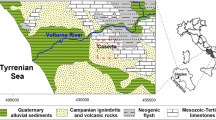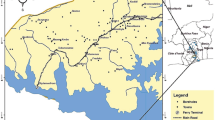Abstract
Climate change, population growth, and agriculture contribute to a qualitative and quantitative deterioration of groundwater reserves. The protection of natural water resources is crucial, especially in arid areas. The purpose of this paper is to map the vulnerability and risk mapping of a Moroccan aquifer, i.e., the Figuig oasis, using DRASTIC (depth of water (D), net recharge (R), aquifer media (A), soil (S), topography (T), impact of the vadose zone (I), and hydraulic conductivity (C)) and AVI (aquifer vulnerability index) methods. DRASTIC vulnerability maps have been drawn up for 4 years (1995, 2004, 2008, and 2010). Thematic maps were performed by both methods using the geographic information system (GIS). The DRASTIC method was modified in order to take into account the numerous faults. The AVI method allows estimating the transfer of a pollutant from the surface to the water level. Both methods give consistent results, enhancing high, medium, and moderate vulnerability. Risk assessment of groundwater pollution by septic tanks has been achieved by integrating the modified DRASTIC vulnerability map. Three areas with high, moderate, and low risk assessment have been identified and mapped.









Similar content being viewed by others
References
ABHM (2004) Inventaire des prélèvements d’eau souterraine à partir des nappes de la plaine de Figuig et élaboration des cartes hydrogéologiques de gestion des nappes. (Oujda): 120p
Aller L, Bennett T, Lehr JH, Petty RJ (1987) DRASTIC: a standardized system for evaluating ground water pollution potential using hydrogeologic settings. US Environmental Protection Agency 600/2/035, Washington, DC, p 455p
Allier D, Vittecoq B, Mardhel V (2008) Evaluation de la vulnérabilité intrinsèque des eaux souterraines de la Martinique. BRGM/RP-56283-FR: 81p
Anwar M, Prem CC, Rao VB (2003) Evaluation of groundwater potential of Musi River catchment using DRASTIC index model. In: Venkateshwar BR, Ram MK, Sarala CS, Raju C (eds) Hydrology and watershed management Proceedings of the international conference 18–20, 2002. B. S. Publishers, Hyderabad, pp 399–409
Assou M. (1996) Salinité des sols et qualité des eaux d’irrigation de l’oasis de Figuig. Ministère de l’agriculture et de la mise en valeur agricole, Administration du génie rural, Direction du développement et de la gestion de l’irrigation Rabat: 99 p
Assou M (2001) Qualité des sols de l’oasis de Figuig. Rev H T E 119:38–43
Breil P, Combe M, Etienne H, Zeryouhi I (1977) Le Haut Atlas oriental. Ressources en eau du Maroc; Tome 3. Domaines atlasique et sud-atlasique Notes et mém du Serv Géol du Maroc 231:140–159
CAG (1968) Essais de prospection par méthode électrique dans la région de Figuig, 9–22 août 1968. MTPC/DH/DRE: 7 pp., 1 plan, 2 coupes, 30 sondages électriques
CAG (1974) Etude par prospection électrique et sismique dans la région de Figuig. Rapp inéd MTPC/DH/DRE
Chandrashekhar H, Adiga S, Lakshminarayana V, Jagdeesha CJ, Nataraju C (1999) A case study using the model ‘DRASTIC’ for assessment of groundwater pollution potential. In Proceedings of the ISRS national symposium on remote sensing applications for natural resources: 19–21
Daly D, Dassargues A, Drew D, Dunne S, Goldscheider N, Neale S, Popescu I, Zwahlen F (2002) Main concepts of the “European approach” to karst-groundwater-vulnerability assessment and mapping. Hydrogeol J 10(2):340–345
Doerfliger N, Zwahlen F (1997) EPIK: a new method for outlining of protection areas in kartic environment. In: Günay G, Jonshon AI (eds) Int Symp on Karst Waters and Environmental Impacts. Balkem, Rotterdam, Antalya, pp 117–123
Dresnay RD (1963) Carte géologique du Haut Atlas oriental au 1/200 000, feuille de Bouarfa, Ich, Talzaza et Figuig. Note et Mémoire du Service Géologique du Maroc, Rabat
Foster SSD (1987) Fundamental concepts in aquifer vulnerability, pollution risk and protection strategy. In: Duijvenbooden W. van and Waegeningh H.G van (eds): TNO Committee on Hydrological Research, The Hague. Vulnerability of soil and groundwater to pollution. Proc Inf 38:69–86
GéoAtlas (1993) Etude par prospection électrique dans la région de Figuig. Rapport inédit, MTPC/DH/DRE
GéoAtlas (2004) Etude géophysique par sismique réflexion haut résolution dans la province de Figuig (marché n° 111/2003). DGH. DRPE. 69p. Laâyoune
Gogu RC, Dassargues A (2000a) Current trends and future challenges in groundwater vulnerability assessment using overlay and index methods. Environ Geol 39(6):549–559
Gogu RC, Dassargues A (2000b) Sensitivity analysis for the EPIK method of vulnerability assessment in a small karstic aquifer, southern Belgium. Hydrogeol J 8(3):337–345
Gogu R, Hallet V, Dassargues A (2003) Comparison of aquifer vulnerability assessment techniques. Application to the Néblon river basin (Belgium). Environ Geol 44(8):881–892
Jilali A (2009) Caractérisation hydrogéologique de la nappe de Figuig - Maroc. In Département de Géologie et d'ArGEnCo. Université de Liège, Liège, p 84p
Lallemand-Barrès A (1994) Normalisation des critères d'établissement des cartes de vulnérabilité aux pollutions. Etude documentaire préliminaire. Rapport BRGM R 37928
Moratalla Â, Gômez-Alday J, Sanz D, Castaño S, Heras J (2011) Evaluation of a GIS-based integrated vulnerability risk assessment for the mancha oriental system (SE Spain). Water Resour Manag 25(14):3677–3697
Morris BL, Foster SSD (2000) Cryptosporidium contamination hazard assessment and risk management for British groundwater sources. Water Sci Technol 41(7):67–77
Puigserver DC (2004) Modélisation mathématique de débit et de transport du système aquifère de l’oasis de Figuig en tant qu’outils de gestion des ressources hydriques (Haut Atlas, Maroc sud oriental). In Département de Géochimie, Pétrologie et Prospection Géologique. Université de Barcelone, Barcelone, p 59p
Rahman A (2008) A GIS based DRASTIC model for assessing groundwater vulnerability in shallow aquifer in Aligarh, India. Appl Geogr 28(1):32–53
Stempvoort DV, Ewert L, Wassenaar L (1993) Aquifer vulnerability index: a GIS-compatible method for groundwater vulnerability mapping. Can Water Resour J 18(1):25–37
Vrba J, Zaporozec A (1994) Guidebook on mapping groundwater, International contributions to hydrology: 131. Heinz Heise, Hannover
Acknowledgements
The authors would like to acknowledge the EC-supported project “Distributed Knowledge-Based Energy Saving Networks”—DISKNET, Grant Agreement No: PIRSES-GA-2011-294933.
Author information
Authors and Affiliations
Corresponding author
Rights and permissions
About this article
Cite this article
Jilali, A., Zarhloule, Y. & Georgiadis, M. Vulnerability mapping and risk of groundwater of the oasis of Figuig, Morocco: application of DRASTIC and AVI methods. Arab J Geosci 8, 1611–1621 (2015). https://doi.org/10.1007/s12517-014-1320-3
Received:
Accepted:
Published:
Issue Date:
DOI: https://doi.org/10.1007/s12517-014-1320-3




